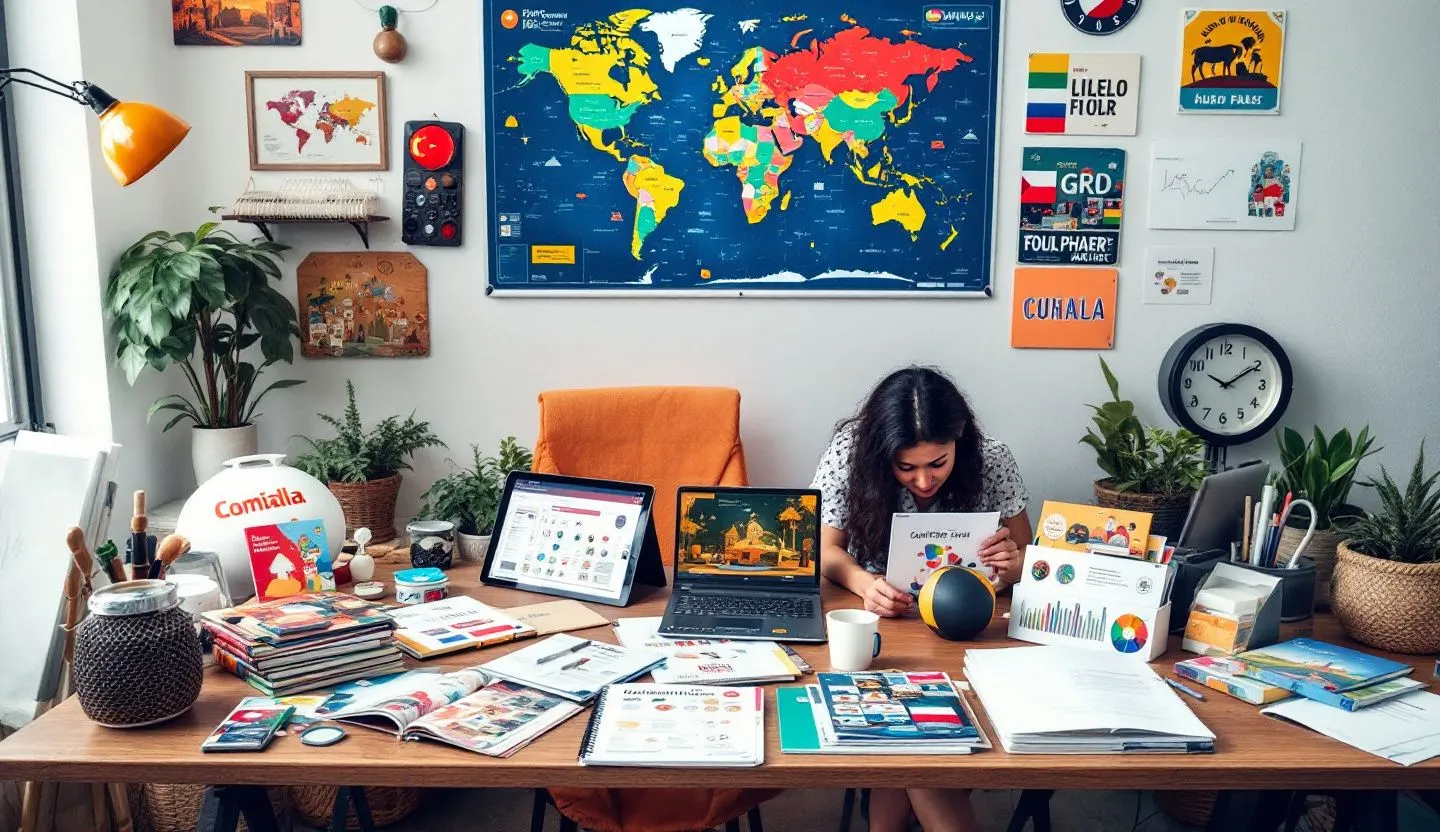Let’s start with the daily tension most of us feel: We are under pressure to execute campaigns faster, stretch resources further, and deliver consistent results everywhere our brand shows up. But here’s the kicker,what resonates with customers in São Paulo falls flat in Seoul. A tagline that soars in London might confuse, or even offend, in Mumbai. If you’re leading enterprise marketing, you know the stakes: Brand equity is hard-earned and easily lost in translation, especially when speed-to-market collides with the realities of local nuance.
I’ve spent years walking this tightrope, working with regional teams, compliance, creative, and tech to get the right message to the right market, at the right moment. And I’ll be honest: Global brand control is always in tension with the local touch. But the brands that get it right? They stop thinking about “translation” and start thinking about “transformation.” That’s what true localized content marketing is about,tailoring your story so it feels native, not just available, in every region you serve.
Why global brands struggle with local relevance
Let’s talk about the real pain. You launch a hero campaign. You brief the regions. Everything’s on track,until you see the rollout. Some markets post on time, some are two weeks late. The creative is inconsistent. Messaging is close, but not quite right. Legal flags a compliance issue in France. The Japan team rewrites everything. The brand team spends days in email threads debating the right shade of blue for the logo in the Middle East.
This isn’t just about lost time or higher costs, though both sting. It’s about eroding trust,internally and externally. Your teams grow frustrated with the process. Local partners start improvising because they can’t wait for HQ. Customers get mixed signals, or worse, feel like an afterthought. I’ve seen “global” campaigns that look like a patchwork quilt, not a brand experience.
It’s no wonder that enterprise marketing leaders lose sleep over this. We’re told to scale, but rarely given the tools to do it without losing the magic of local connection. Standardizing everything is tempting, but sameness kills relevance. Going fully bespoke for each region slows you to a crawl. The stakes are even higher for regulated industries, where a single misstep can mean fines, not just embarrassment.
How the market shift demands a new approach
The world has changed. Customers don’t just appreciate local relevance,they expect it. Research from CSA Research shows that 76% of online shoppers prefer to buy products with information in their own language. But it’s not just about language. It’s about context. It’s about showing you understand what matters to people in Mexico City or Munich, not just New York.
Technology has made the world smaller, but expectations bigger. Customers see the best global brands as benchmarks, and they expect seamless, personalized experiences everywhere. Meanwhile, regulatory scrutiny is rising, and the cost of missteps grows every year. GDPR, CCPA, local advertising laws,these are now part of the marketer’s daily vocabulary.
And then there’s the speed factor. Social cycles are shorter, trends move faster, and the shelf life of content is shrinking. If your campaign takes months to localize, it’s already outdated. The brands winning today have found a way to turn this challenge into an advantage. They’re not just localizing content,they’re building systems for agile, compliant, brand-right adaptation at scale.
Moving from translation to true localization
Localization isn’t just translation. If you’re reading this, you know that already. But it’s worth repeating, because I’ve seen too many enterprise campaigns falter when “just translate the copy” is the operating model. Translation changes words. Localization changes meaning, context, and emotional impact.
Here’s a real example: A global SaaS company I worked with wanted to run a “Spring into Productivity” campaign across all markets. The concept played well in the US, where spring symbolizes renewal. But in Australia, spring happens in September, not March. In India, the notion of spring cleaning doesn’t have the same cultural resonance. The team pivoted. In Australia, they led with “Kickstart Your New Financial Year.” In India, the focus shifted to post-holiday productivity. Same campaign backbone, but the local angle made it land.
Localized content marketing means asking, “How do we make this idea feel like it started here, not just arrived here?” That requires research, empathy, and input from local teams who understand the culture, not just the language.
The operational cost of poor localization
Let’s talk about what happens when we get it wrong. Beyond the creative cringe, there’s a very real operational and financial cost. I’ve seen enterprise teams lose weeks reworking assets, re-negotiating with compliance, or firefighting after a social backlash over a culturally insensitive ad. Every round of fixes slows your speed-to-market and eats into your budget.
And then there’s risk. When content misses regulatory nuances,say, a pharmaceutical ad that doesn’t meet local disclosure standards, or a financial services email that violates data privacy rules,the consequences are not just reputational. They’re legal. For regulated brands, a single error can mean millions in fines, not to mention the cost of remediation.
But even if you avoid the big mistakes, poor localization leads to something subtler but just as damaging: disengagement. If your campaigns feel generic, they’re ignored. If they feel off, they’re shared for the wrong reasons. The operational cost isn’t just in dollars,it’s in lost opportunity and eroded brand equity.
What real localized content marketing looks like in practice
- They build localization into the campaign from day one: They don’t create in English, then ask for translation. They start with a creative brief that asks, “How will this work in our top five markets?” They involve local teams early and treat their input as essential, not optional.
This means setting up regular syncs with regional leads, sharing campaign concepts before creative is locked, and using collaborative platforms to gather feedback in real-time. The result: fewer surprises, more buy-in, and smoother execution.
- They balance global brand standards with flexible local adaptation: It’s not about letting every region do whatever they want. It’s about providing clear brand guidelines,logo usage, tone of voice, color palettes,alongside toolkits for local teams to adapt assets quickly.
The best systems use digital asset management platforms that lock down non-negotiables, but allow for flexible copy, imagery, and CTA swaps. Think Figma libraries with “must-have” and “nice-to-have” layers, or templated campaign builders with editable text fields but fixed brand marks.
- They make compliance and governance seamless, not a roadblock: Compliance is non-negotiable, but it doesn’t have to slow you down. The best teams work closely with legal and risk from the start, building checklists and automated review flows into their process.
This might mean using workflow automation that routes localized assets to the right approvers, or embedding regulatory guidance directly into creative templates. The goal: No more last-minute legal surprises, and no more rogue assets slipping through.

Why translation alone falls short for enterprise brands
I’ve seen it firsthand: An enterprise brand invests in a top-tier translation service, thinking this will solve their global consistency problem. The copy is accurate, the grammar is perfect. But something’s missing. The campaign doesn’t resonate. Engagement lags. Local teams quietly create their own versions, and suddenly, the brand feels fragmented again.
Why does this happen? Because translation changes words, but not meaning. It doesn’t capture local idioms, humor, or context. For example, a food delivery brand launched a “Taste of Home” campaign for expats, translated across 20 markets. In Spain, the phrase lost its emotional weight because the local concept of “home cooking” is tied to family and tradition, not just comfort food. The Spanish team rewrote the campaign to focus on “Sabores de la Abuela”,grandmother’s flavors,and saw engagement soar.
Translation is a tool. Localization is a strategy. For true enterprise impact, you need both,but you can’t stop at language. You need local insight, creative adaptation, and operational systems that make it easy to do the right thing at scale.
Building operational systems for scalable, secure localization
As our marketing footprint grows, so does the complexity. More regions, more regulations, more stakeholders. The only way to keep pace is to invest in systems that make localization efficient, secure, and scalable.
This starts with your tech stack. Digital asset management (DAM) platforms, creative collaboration tools, and content workflow automation are now table stakes. But the real differentiator is integration. When your DAM, project management, and compliance tools talk to each other, you reduce manual work and speed up approvals.
Security is non-negotiable, especially for regulated industries. Content must be protected at every stage, with clear audit trails and permission controls. Legal and risk teams need visibility, but not bottlenecks. The best solutions offer role-based access, automated version control, and secure sharing with partners.
But systems alone aren’t enough. You need clear processes, trained teams, and accountability. That means regular training for local marketers, shared playbooks for asset adaptation, and feedback loops that surface what’s working (and what isn’t) in each region.
The next-gen DAM for enterprise
Get more than just storage. Get the DAM that dramatically improves content velocity and brand compliance.The role of cross-functional teams in localized content marketing
If you want to get localization right, you can’t do it alone. The days of HQ dictating every creative decision are over. Success depends on cross-functional collaboration,marketing, creative, legal, IT, compliance, and local teams all working together.
I’ve found that the most effective teams are those that treat local marketers as true partners, not just executors. They invite them into the creative process early, listen to their feedback, and celebrate their wins. This builds trust and ensures the final output feels authentic, not forced.
IT and operations leaders play a critical role, too. They ensure the systems are secure, compliant, and integrated. Legal and risk teams define the guardrails, but also help solve for nuance,like how to handle user data in Brazil versus Germany, or what disclosures are needed in a new APAC market.
When everyone is aligned around a shared goal,making the brand feel local, not just global,the results speak for themselves. Campaigns land faster, with fewer rewrites. Compliance issues drop. Engagement rises. And the brand feels more human, everywhere it shows up.
Balancing brand consistency and local flexibility
If you’re leading a global brand, you know the tension: How do you give local teams the freedom to adapt, without losing control of the brand? There’s no one-size-fits-all answer, but the best brands create clear boundaries.
- Start with non-negotiables: Define what can’t be changed,logo, primary colors, tone of voice, legal copy. Document these in a brand guide that’s accessible and easy to reference.
- Next, build in flexibility: Identify what local teams can adapt,headlines, imagery, cultural references, CTAs. Create editable templates or modular content blocks that make adaptation easy and fast.
- Finally, enable feedback: Set up regular reviews with local teams to learn what’s working and where they’re improvising. Use these insights to update your playbooks and toolkits.
This isn’t about giving up control. It’s about building trust and empowering your teams to do their best work. When local marketers feel supported, not constrained, they’re more likely to stay on brand,and go above and beyond.
The compliance and risk perspective in global content
Compliance is everyone’s job, but it’s especially critical for enterprise brands. Every region has its own rules,what’s allowed in one market can get you into hot water in another. And as privacy laws evolve, the risk of non-compliance only grows.
I’ve seen compliance officers become invaluable partners in the localization process. They help define the red lines,what can and can’t be said, what disclosures are needed, how customer data is handled. The best marketing teams bring compliance in early, so issues are caught before assets go live.
Technology helps here, too. Automated workflows, audit trails, and permission controls make it easier to manage risk at scale. But nothing replaces clear communication and shared accountability. When compliance is woven into the process, not tacked on at the end, everyone wins.
Measuring the impact of localized content marketing
How do you know your localized content marketing is working? Metrics matter, but so does qualitative feedback. I look for a few key signals:
- Engagement rates in local markets: Are people clicking, sharing, and responding? If your localized content is resonating, you’ll see higher open rates, click-throughs, and shares compared to generic campaigns.
- Brand consistency audits: Are your assets on brand, everywhere they appear? Regular audits help catch drift before it becomes a problem.
- Feedback from local teams and partners: Are they proud to share the content, or do they feel the need to “fix” it? The less rework, the better.
- Regulatory compliance: Are you avoiding fines and warnings? Are your legal and risk teams spending less time on last-minute reviews?
Ultimately, the best measure is business impact. Are localized campaigns driving revenue, leads, or brand lift in target markets? Are you winning mindshare against local competitors? When localization works, you feel it in the numbers and the narrative.
Real-world examples of enterprise localized content marketing
- Coca-Cola’s “Share a Coke” campaign: Instead of running a single global campaign, they localized by printing popular local names on bottles in each country. In China, they used nicknames and relationship terms. In Australia, they chose the most common names. The result: a global idea that felt personal everywhere.
- Netflix’s content localization: Netflix invests heavily in dubbing, subtitles, and even original local programming. Their marketing adapts to local humor, trends, and even memes. In India, they partnered with Bollywood stars for social campaigns. In Brazil, they tapped into telenovela tropes. The brand feels “local” no matter where you log in.
- A global fintech company: When launching a new payment solution, they worked with local partners to adapt onboarding flows, legal disclosures, and support content. The result was faster adoption, fewer compliance issues, and higher customer satisfaction across markets.
These brands don’t just translate,they transform. They invest in systems, people, and processes that make localization a competitive advantage.
The future of localized content marketing at scale
The next wave of localized content marketing is about speed, scale, and intelligence. AI-powered tools are making it easier to automate translation, flag compliance issues, and personalize content at the segment level. But the human touch still matters,especially when it comes to cultural nuance and emotional resonance.
I believe the future is hybrid: Automation to handle the heavy lifting, with local experts providing the final polish. The brands that win will be those that build flexible systems, empower cross-functional teams, and never lose sight of what makes their message matter in every market.
For enterprise marketers, this means staying curious, investing in new skills, and building partnerships across the business. It means measuring what matters,not just clicks and conversions, but brand perception and market relevance. And it means being willing to learn from every market, every campaign, every team.
Localized content marketing is no longer a “nice to have”,it’s essential for any enterprise brand that wants to grow, protect its reputation, and connect meaningfully with customers worldwide. The tension between speed, scale, and control is real, but it’s not insurmountable. By building operational systems that enable secure, compliant, and flexible localization, you can move faster and smarter,without sacrificing brand integrity.
The real opportunity lies in treating localization as a strategic capability, not a last-mile task. That means investing in the right technology, empowering local teams, and building cross-functional partnerships that put the customer at the center. The brands that make this shift will find themselves not just keeping up with global competition, but setting the pace. Localized content marketing, done right, turns the complexity of global markets into a source of strength, innovation, and real impact,one authentic connection at a time.







